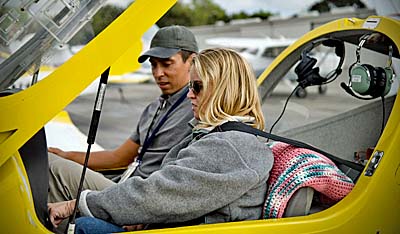 For more than 15 years one class of Light-Sport Aircraft has been held down in America even while it has been burgeoning in other parts of the world. The class is LSA gyroplanes, for a decade and half prevented from selling a fully-built model in the USA.
How well is the category doing in other parts of the world? The answer draws on reports from dominant engine producer, Rotax Aircraft Engines, which has reported for years that the class of aircraft buying the most engines has been gyroplanes. Considering the many fixed wing designs also use that engine brand, Rotax’s statement carries tremendous weight.
The story about why gyroplanes were denied the full privileges of Special LSA — and therefore have to be built as Experimental Amateur Built (EAB) kits in America — is a long, sad story …but it is one that appears to be ending, thank goodness!
As described in this recent article about FAA’s plans for revised regulation of LSA (as well as other non-LSA segments), the leash around the neck of gyroplane producers is set for release.
For more than 15 years one class of Light-Sport Aircraft has been held down in America even while it has been burgeoning in other parts of the world. The class is LSA gyroplanes, for a decade and half prevented from selling a fully-built model in the USA.
How well is the category doing in other parts of the world? The answer draws on reports from dominant engine producer, Rotax Aircraft Engines, which has reported for years that the class of aircraft buying the most engines has been gyroplanes. Considering the many fixed wing designs also use that engine brand, Rotax’s statement carries tremendous weight.
The story about why gyroplanes were denied the full privileges of Special LSA — and therefore have to be built as Experimental Amateur Built (EAB) kits in America — is a long, sad story …but it is one that appears to be ending, thank goodness!
As described in this recent article about FAA’s plans for revised regulation of LSA (as well as other non-LSA segments), the leash around the neck of gyroplane producers is set for release.Great News for Gyroplanes Such as Magni Gyro + a Video Pilot Report (at Midwest LSA Expo)
For more than 15 years one class of Light-Sport Aircraft has been held down in America even while it has been burgeoning in other parts of the world. The class is LSA gyroplanes, for a decade and half prevented from selling a fully-built model in the USA.
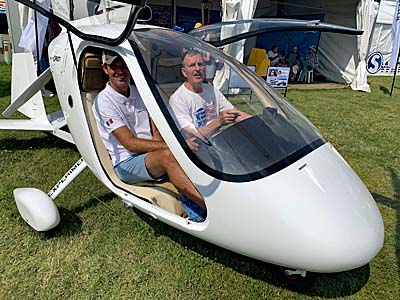
The story about why gyroplanes were denied the full privileges of Special LSA — and therefore have to be built as Experimental Amateur Built (EAB) kits in America — is a long, sad story …but it is one that appears to be ending, thank goodness!
As described in this recent article about FAA’s plans for revised regulation of LSA (as well as other non-LSA segments), the leash around the neck of gyroplane producers is set for release. When the revised regulation is issued — possibly in 2021 — fully built Special LSA gyroplanes are expected to be approved.
In the U.S. market today, Magni ranks as the #2 seller, according to registrations captured on our Tableau Public page (chart below).
M24 Orion
Italian company Magni Gyro calls their M24 Orion model an “enclosed side-by-side two-seat factory built gyroplane.” Currently in the USA, all models of Magni gyroplanes must be built as kits but until the new regulation arrives, dealers in the USA are prepared to assist this relatively modest effort.

Posing by their deluxe M24 Orion are Luca Magni (R) and sales director, Chiara Curioni, seen at Oshkosh 2019.
Orion is structurally based on a “chrome-alloy aeronautical 4130 steel that is TIG welded,” said Magni. The fully enclosed model has a carbon fiber fuselage, undercarriage, wheel pants, and rudder.
Integral fuel tank manufactured in epoxy resin reinforced with fiberglass hold 21.5 gallons, a fuel capacity that allows flights of up to four hours at a cruise speed of 75 to 95 mph. In this article you can read about a flight from Texas to Cuba by a pair of Magni gyros, proving the range capability of these flying machines.
Power on M24 Orion comes from a turbo Rotax 914 providing 115 horsepower from the four cylinder, four stroke, water-cooled engine fitted with a mechanical rotor blade pre-rotator. Orion’s three-blade carbon fibre propeller can be optimized by ground adjustable pitch.
Magnin goes beyond some gyro producers — the company makes its own 28-foot diameter, two-bladed rotor from composite materials.

For controls, Orion offers full dual joystick and pedals for each occupant. Standard equipment includes electric trim.
M24 Orion is attractive and roomy inside. For carriage, Orion is equipped with three easily-accessed baggage compartments. Its cabin heating system combined with full enclosure allows M24 to remain comfortable even on cold winter days.
From either seat the view is enormous, a key benefit of gyroplanes without nearby wing structure to block your view. Orion would definitely be more comfortable for long flights or in chilly weather but the open cockpit M16 Trainer or M22 Voyager models deliver an even more expansive view.
Combined with a gyroplane’s unique handling and performance, these machines make wonderful viewing platforms.
Magni’s “Plus” Series
In the last year, Magni Gyro introduced use of the new Rotax 915iS turbocharged 141 horsepower, fuel injection-powered engine. Models with the most powerful Rotax yet are designated by the suffix, “Plus.”

One of Magni’s American customers, identified only as M.B., wrote the company to say, “As the proud owner of the first Magni M16 Plus in the USA, I can tell you the performance is like none other. Takeoff, climb and speed performance exceeded my expectations. This gyroplane has incredible power reserve, more than enough for every aspect of flight. Takeoffs are breathtaking, cruise is smooth and landings are gentle. The Magni M16 Plus is an incredible flying machine!”
One final comment of worthy note: In late 2016, the Magni Gyro factory in Besnate, Italy produced the company’s 1,000th gyroplane.
See lots of video experiences in Magni gyros at this link. — Come along for a flight as we perform a Video Pilot Report in an M16 Magni gyroplane with representative and expert gyro pilot, Greg Gremminger. You will clearly see a series of interesting in-flight maneuvers.
 For more than 15 years one class of Light-Sport Aircraft has been held down in America even while it has been burgeoning in other parts of the world. The class is LSA gyroplanes, for a decade and half prevented from selling a fully-built model in the USA.
How well is the category doing in other parts of the world? The answer draws on reports from dominant engine producer, Rotax Aircraft Engines, which has reported for years that the class of aircraft buying the most engines has been gyroplanes. Considering the many fixed wing designs also use that engine brand, Rotax’s statement carries tremendous weight.
The story about why gyroplanes were denied the full privileges of Special LSA — and therefore have to be built as Experimental Amateur Built (EAB) kits in America — is a long, sad story …but it is one that appears to be ending, thank goodness!
As described in this recent article about FAA’s plans for revised regulation of LSA (as well as other non-LSA segments), the leash around the neck of gyroplane producers is set for release.
For more than 15 years one class of Light-Sport Aircraft has been held down in America even while it has been burgeoning in other parts of the world. The class is LSA gyroplanes, for a decade and half prevented from selling a fully-built model in the USA.
How well is the category doing in other parts of the world? The answer draws on reports from dominant engine producer, Rotax Aircraft Engines, which has reported for years that the class of aircraft buying the most engines has been gyroplanes. Considering the many fixed wing designs also use that engine brand, Rotax’s statement carries tremendous weight.
The story about why gyroplanes were denied the full privileges of Special LSA — and therefore have to be built as Experimental Amateur Built (EAB) kits in America — is a long, sad story …but it is one that appears to be ending, thank goodness!
As described in this recent article about FAA’s plans for revised regulation of LSA (as well as other non-LSA segments), the leash around the neck of gyroplane producers is set for release.

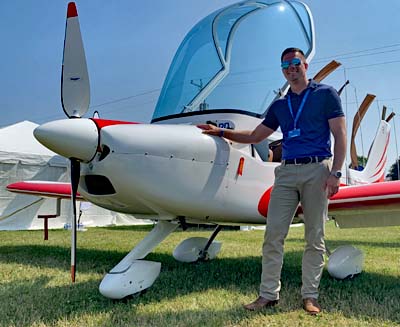
 The design appears connected to the Fly Synthesis Texan from Italy and the designer reportedly assisted Sunward as they worked on this project. Yet a glance at the Texan (at bottom) shows numerous differences
The design appears connected to the Fly Synthesis Texan from Italy and the designer reportedly assisted Sunward as they worked on this project. Yet a glance at the Texan (at bottom) shows numerous differences All these differences suggest that if Aurora is a Texan, it is an improvement on the original. The company said Aurora is the first Chinese brand Light-Sport Aircraft to receive Chinese (CAAC) airworthiness certification.
All these differences suggest that if Aurora is a Texan, it is an improvement on the original. The company said Aurora is the first Chinese brand Light-Sport Aircraft to receive Chinese (CAAC) airworthiness certification.

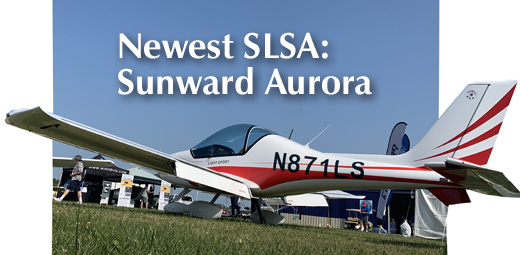
 A good marketer Denney’s Kitfox once employed a whole staff of sales people following up on loads of leads that the then-new design was generating. Even now, decades later, Kitfox, doing business as
A good marketer Denney’s Kitfox once employed a whole staff of sales people following up on loads of leads that the then-new design was generating. Even now, decades later, Kitfox, doing business as  “I’ve been involved with autos and motorcycles my whole life,” Chris detailed, “but I had a passion for aviation. When the chance came to acquire the Kitfox Lite, I jumped.” With other family members, Chris established his company and set to building Kitfox Lite as a series of differently configured models… F1 UL base kit, F2 Flyer, F3 Speed, F4 Monster, and F5 Fujita. Each model step comes with addition features or equipment.” Yet, as Badland advises, “Every model is 100% Part 103 capable.” In fact, the aircraft at Oshkosh 2019 (nearby photos) weighed a mere 235 pounds, generously under the Part 103 limits of 254 pounds empty.
“I’ve been involved with autos and motorcycles my whole life,” Chris detailed, “but I had a passion for aviation. When the chance came to acquire the Kitfox Lite, I jumped.” With other family members, Chris established his company and set to building Kitfox Lite as a series of differently configured models… F1 UL base kit, F2 Flyer, F3 Speed, F4 Monster, and F5 Fujita. Each model step comes with addition features or equipment.” Yet, as Badland advises, “Every model is 100% Part 103 capable.” In fact, the aircraft at Oshkosh 2019 (nearby photos) weighed a mere 235 pounds, generously under the Part 103 limits of 254 pounds empty. “Expect to spend anywhere between $11,700-$28,500 for a brand spanking new Badland kit,” said Chris, the owner of Badland Aircraft. “You can expect to spend another $2,000-$4,500 for the firewall forward parts unless you have an engine laying around.”
“Expect to spend anywhere between $11,700-$28,500 for a brand spanking new Badland kit,” said Chris, the owner of Badland Aircraft. “You can expect to spend another $2,000-$4,500 for the firewall forward parts unless you have an engine laying around.” “With the folding wings and the ability to park it in a 20 foot by 8.5 foot enclosed car trailer or a single car garage, you’ll appreciate the versatility.”
“With the folding wings and the ability to park it in a 20 foot by 8.5 foot enclosed car trailer or a single car garage, you’ll appreciate the versatility.”
 After impressing European pilots at the big German show called Aero Friedrichshafen, producer InnovAviation brought their sleek and sexy FX1 for Americans to see at Oshkosh 2019. For American representation, the Italian producer will be teaming up with Deon Lombard, who also represents the
After impressing European pilots at the big German show called Aero Friedrichshafen, producer InnovAviation brought their sleek and sexy FX1 for Americans to see at Oshkosh 2019. For American representation, the Italian producer will be teaming up with Deon Lombard, who also represents the  I can’t imagine how anyone can look at Alfredo Di Cesare‘s creation and not react with admiration. Italian companies are known for dashing and innovative lines (think: Ferrari or any number of auto companies or LSA giant, Tecnam). Design talent is definitely not lacking from Italian products; FX1 should be an object of national pride.
I can’t imagine how anyone can look at Alfredo Di Cesare‘s creation and not react with admiration. Italian companies are known for dashing and innovative lines (think: Ferrari or any number of auto companies or LSA giant, Tecnam). Design talent is definitely not lacking from Italian products; FX1 should be an object of national pride. Sitting in FX1 at Oshkosh, it is immediately clear this is not the JetFox97. The older model was much more challenging to enter as you had to contort your body to wriggle around structure. Once in it was comfortable but the all-new FX1 is far easier partly thanks to those shapely curved doors.
Sitting in FX1 at Oshkosh, it is immediately clear this is not the JetFox97. The older model was much more challenging to enter as you had to contort your body to wriggle around structure. Once in it was comfortable but the all-new FX1 is far easier partly thanks to those shapely curved doors. A luggage compartment aft of the cockpit has access doors on each side and the space is open side to side giving ample area for items you wish to transport to your destination. For things you might want in flight, a space behind the occupant’s heads is available. Seats are comfortable and the cockpit measures a broad 49 inches wide (almost 10 inches more than a Cessna 172).
A luggage compartment aft of the cockpit has access doors on each side and the space is open side to side giving ample area for items you wish to transport to your destination. For things you might want in flight, a space behind the occupant’s heads is available. Seats are comfortable and the cockpit measures a broad 49 inches wide (almost 10 inches more than a Cessna 172).
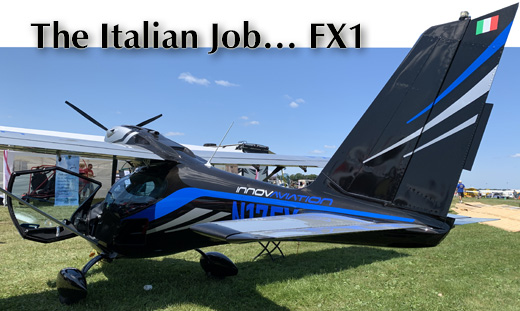
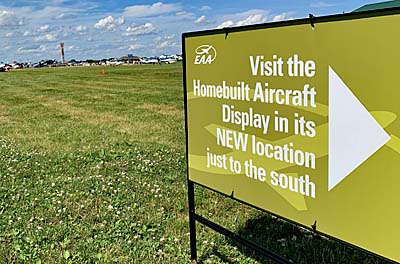 Cruising the grounds at Oshkosh, looking for aircraft to report, I looked around the all-new Homebuilt Area. This group has long occupied a fairly spacious grassy area in a good location south of the Warbirds Area, said to be Oshkosh’s biggest draw. However, for 2019 EAA relocated the area bringing vendors closer to the densest customer traffic, which may encourage more attendees to examine their aircraft. Several exhibitors I spoke to seemed content with the new location.
Cruising the grounds at Oshkosh, looking for aircraft to report, I looked around the all-new Homebuilt Area. This group has long occupied a fairly spacious grassy area in a good location south of the Warbirds Area, said to be Oshkosh’s biggest draw. However, for 2019 EAA relocated the area bringing vendors closer to the densest customer traffic, which may encourage more attendees to examine their aircraft. Several exhibitors I spoke to seemed content with the new location. Truthfully, Van’s Aircraft Vice President and Chief Engineer Rian Johnson is only displaying a personal project. RV-5 was never offered for sale and won’t be now. Yet the light aircraft enthusiast in me noticed it right away. Probably like most other attendees I wondered, “What is that?
Truthfully, Van’s Aircraft Vice President and Chief Engineer Rian Johnson is only displaying a personal project. RV-5 was never offered for sale and won’t be now. Yet the light aircraft enthusiast in me noticed it right away. Probably like most other attendees I wondered, “What is that? “Some years back, I was up in a loft storage area looking for something and uncovered a dusty airframe. When I asked Dick about it, he asked, ‘Do you want it?’ Be careful what you ask for,” Rian noted although he did eventually tackle the restoration project marrying the airframe of RV-5 to the canopy of RV-2.
“Some years back, I was up in a loft storage area looking for something and uncovered a dusty airframe. When I asked Dick about it, he asked, ‘Do you want it?’ Be careful what you ask for,” Rian noted although he did eventually tackle the restoration project marrying the airframe of RV-5 to the canopy of RV-2.
 While organized as completely separate companies, Vashon shares common ownership through the name John Torode, the founder of Dynon Avionics. The two businesses work hard to stay separate but it’s clear one success might help the other just as John’s earlier success in the tech industry lead to Dynon being formed.
While organized as completely separate companies, Vashon shares common ownership through the name John Torode, the founder of Dynon Avionics. The two businesses work hard to stay separate but it’s clear one success might help the other just as John’s earlier success in the tech industry lead to Dynon being formed. Estimated production numbers in 2019, if this is something you wish to divulge.
Estimated production numbers in 2019, if this is something you wish to divulge. Is the R7 only for those interested in Sport Pilot/LSA?
Is the R7 only for those interested in Sport Pilot/LSA? Anecdotes from customers/operators and how you have addressed requests/problems (the true indicator of excellence).
Anecdotes from customers/operators and how you have addressed requests/problems (the true indicator of excellence). Where is your exhibit located and who will a person meet there?
Where is your exhibit located and who will a person meet there?
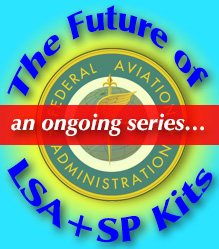 The update to industry covered a lot of ground but here we’ve tried to make it a quicker read.
The update to industry covered a lot of ground but here we’ve tried to make it a quicker read. Regarding the much-anticipated max weight increase, FAA refers to a “Power Index.” This term means a formula-based method to replace maximum takeoff weight in the definition of a LSA, involving wing area, horsepower, and takeoff weight.
Regarding the much-anticipated max weight increase, FAA refers to a “Power Index.” This term means a formula-based method to replace maximum takeoff weight in the definition of a LSA, involving wing area, horsepower, and takeoff weight. The FAA Reauthorization Act of 2018 includes a deadline of 2023 for implementing a key mandate that suggests the longest it should take. Once an NPRM is published, a comment period follows to hear from the public after which FAA needs time to address the concerns raised during that comment period. After closure of that comment period, the FAA has 16 months to publish the Final Rule.
The FAA Reauthorization Act of 2018 includes a deadline of 2023 for implementing a key mandate that suggests the longest it should take. Once an NPRM is published, a comment period follows to hear from the public after which FAA needs time to address the concerns raised during that comment period. After closure of that comment period, the FAA has 16 months to publish the Final Rule.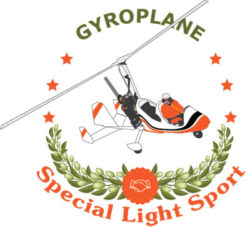 “All of these requests are on the table,” FAA acknowledged in the June teleconference. Of course, this does not mean all are certain to be included, but they represent a “huge opportunity [for industry and for pilots].”
“All of these requests are on the table,” FAA acknowledged in the June teleconference. Of course, this does not mean all are certain to be included, but they represent a “huge opportunity [for industry and for pilots].” Under this more performance-based approach, LSA manufacturers would have more flexibility in making trade-offs among these parameters to meet a new power index limit. That new limit is intended to allow for up to a safe, robust, four-seat airplane.
Under this more performance-based approach, LSA manufacturers would have more flexibility in making trade-offs among these parameters to meet a new power index limit. That new limit is intended to allow for up to a safe, robust, four-seat airplane. “The Flight Standards people are considering [aerial work],” said FAA.
“The Flight Standards people are considering [aerial work],” said FAA. Single Lever Control
Single Lever Control


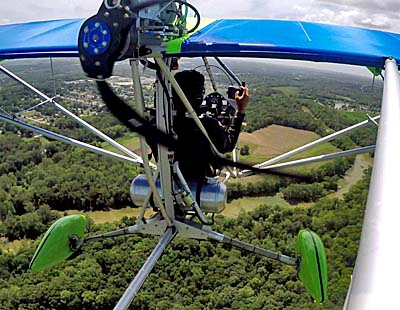 At Henry’s age 13, the Scotts ordered an Aerolite. This followed many flights in a Cessna 150 with his father, where he learned all the basics of flight while someone was ready to assist when (and if) needed. However, at his youthful age and unable to obtain a Private Pilot certificate, Henry could not solo the C-150.
At Henry’s age 13, the Scotts ordered an Aerolite. This followed many flights in a Cessna 150 with his father, where he learned all the basics of flight while someone was ready to assist when (and if) needed. However, at his youthful age and unable to obtain a Private Pilot certificate, Henry could not solo the C-150.

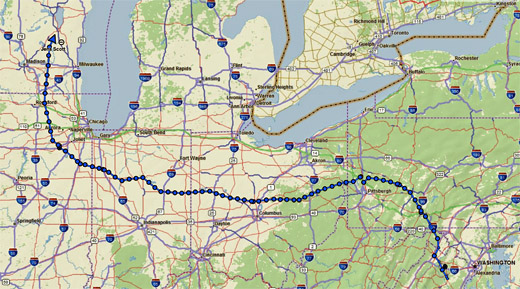


 “Jabiru Aircraft will be offering an increased warranty at Oshkosh 2019, lasting the duration of the show,” Scott explained, revealing great confidence in this roomiest of Light-Sport Aircraft. “The warranty offered will be five years or 1,000 hours, whichever occurs first, for the airframe and the engine.”
“Jabiru Aircraft will be offering an increased warranty at Oshkosh 2019, lasting the duration of the show,” Scott explained, revealing great confidence in this roomiest of Light-Sport Aircraft. “The warranty offered will be five years or 1,000 hours, whichever occurs first, for the airframe and the engine.”
 In case the J230-D price tag sounds beyond your budget, remember Jabiru has other choices.
In case the J230-D price tag sounds beyond your budget, remember Jabiru has other choices.
 The cantilevered all-metal design has excellent ramp appeal, good specifications, and approval as a Special Light-Sport Aircraft is underway at this time, the developer said. He also added, is coming to the USA, to Florida, to be manufactured. The Brazilian invasion continues…
The cantilevered all-metal design has excellent ramp appeal, good specifications, and approval as a Special Light-Sport Aircraft is underway at this time, the developer said. He also added, is coming to the USA, to Florida, to be manufactured. The Brazilian invasion continues… Evidence of Brazil’s prowess in creating aircraft that fit the LSA category include the excellent
Evidence of Brazil’s prowess in creating aircraft that fit the LSA category include the excellent  “All parts are manufactured with a high-speed CNC machine and precision tooling jigs,” André clarified. The well-equipped deluxe Hero with “complete options, is priced at $180,000 (U.S. dollars).
“All parts are manufactured with a high-speed CNC machine and precision tooling jigs,” André clarified. The well-equipped deluxe Hero with “complete options, is priced at $180,000 (U.S. dollars). However, Pop Hero will still be delivered with Bose A20 headset, the Sensenich three blade prop, and sidestick. The lower-cost model is not pictured with this article “because we are working in its assembly, yet it is basically the same without winglets,” André said.
However, Pop Hero will still be delivered with Bose A20 headset, the Sensenich three blade prop, and sidestick. The lower-cost model is not pictured with this article “because we are working in its assembly, yet it is basically the same without winglets,” André said.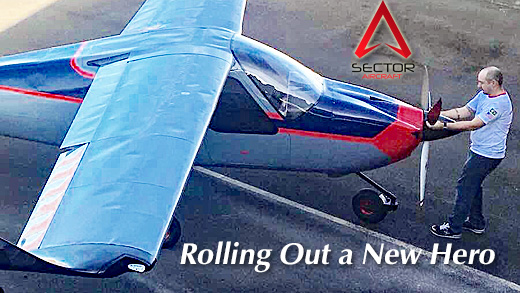
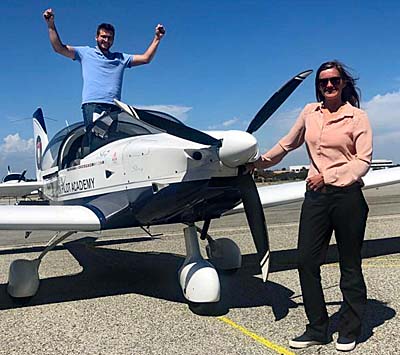


 It’s not just pilots either. Although it’s a story worthy of another article, mechanics are predicted to have even higher job opportunities with pay scales increasing to entice trained workers. This is a great time to be a young person pursing aviation, better than I’ve seen in many decades of following aviation closely.
It’s not just pilots either. Although it’s a story worthy of another article, mechanics are predicted to have even higher job opportunities with pay scales increasing to entice trained workers. This is a great time to be a young person pursing aviation, better than I’ve seen in many decades of following aviation closely.

 In 2018, LAMA honored Adam Morrison, the steady hand at the tiller of the ASTM committee that writes and updates the industry consensus standards that allow LSA to fly in America and other countries without having to go through terribly expensive Part 23 (Type Certificate) level approval.
In 2018, LAMA honored Adam Morrison, the steady hand at the tiller of the ASTM committee that writes and updates the industry consensus standards that allow LSA to fly in America and other countries without having to go through terribly expensive Part 23 (Type Certificate) level approval. For this 28th year of this award, aviation professionals have been invited to submit a name for consideration. From all the nominations received, the one with the most votes wins. Very simple rules guide the vote.
For this 28th year of this award, aviation professionals have been invited to submit a name for consideration. From all the nominations received, the one with the most votes wins. Very simple rules guide the vote.
 In an age where many Light-Sport Aircraft run $150,000, to well… possibly much more, “affordability” becomes something of a tortured word. What might seem affordable to a pilot that can buy a nearly one million dollar Cirrus SR22 is vastly different from what is affordable to most readers of this website. So, how affordable can Aerolite be to warrant my claiming “super affordability?”
In an age where many Light-Sport Aircraft run $150,000, to well… possibly much more, “affordability” becomes something of a tortured word. What might seem affordable to a pilot that can buy a nearly one million dollar Cirrus SR22 is vastly different from what is affordable to most readers of this website. So, how affordable can Aerolite be to warrant my claiming “super affordability?” Consider this perspective. Automobile companies, building tens or hundreds of thousands of a single model, have an average U.S. selling price of more than $35,000 in 2019. Yet here is an airplane, being built at a tiny fraction of the quantity of any automobile, selling for as little as half the price of the average new car. I find that amazing — and it appears a sufficient number to keep U-Fly-It active and profitable, so much so that the DeLand, Florida company can’t keep up.
Consider this perspective. Automobile companies, building tens or hundreds of thousands of a single model, have an average U.S. selling price of more than $35,000 in 2019. Yet here is an airplane, being built at a tiny fraction of the quantity of any automobile, selling for as little as half the price of the average new car. I find that amazing — and it appears a sufficient number to keep U-Fly-It active and profitable, so much so that the DeLand, Florida company can’t keep up.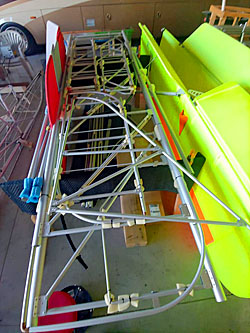
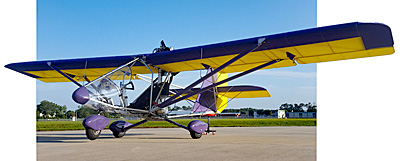 Is Hirth’s 28-horsepower F33 enough power for bigger pilots, say someone weighing 250 pounds? Dennis answered.
Is Hirth’s 28-horsepower F33 enough power for bigger pilots, say someone weighing 250 pounds? Dennis answered. Are Aerolite prices enticing for what many consider to be a dandy little airplane? Perhaps the following answer sums it up. When asked by a customer if U-Fly-It has any plans for a two seat model, Dennis’ responded, “We are building so many single seaters that we just don’t have time to make a two-seater. We literally can not build them fast enough.”
Are Aerolite prices enticing for what many consider to be a dandy little airplane? Perhaps the following answer sums it up. When asked by a customer if U-Fly-It has any plans for a two seat model, Dennis’ responded, “We are building so many single seaters that we just don’t have time to make a two-seater. We literally can not build them fast enough.”
 Then came a pause in the juggernaut that is
Then came a pause in the juggernaut that is 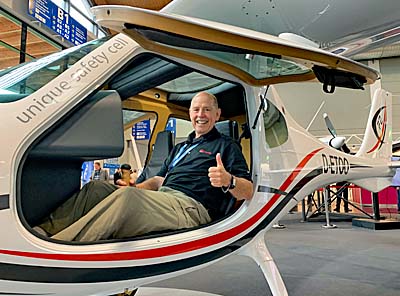 F2’s cabin is 3.1 inches wider — now 51 inches wide, among the broadest in the category — and two inches taller than the CT series’ cabins. Door dimensions have also been increased, making for easier entry and exit. The entry door is set 2.3 inches lower than those in the CT series and pilots who are less flexible will appreciate these changes. Four cabin windows and a sunroof in the rear give the cockpit an open feeling and improve overall visibility, boasts Flight Design.
F2’s cabin is 3.1 inches wider — now 51 inches wide, among the broadest in the category — and two inches taller than the CT series’ cabins. Door dimensions have also been increased, making for easier entry and exit. The entry door is set 2.3 inches lower than those in the CT series and pilots who are less flexible will appreciate these changes. Four cabin windows and a sunroof in the rear give the cockpit an open feeling and improve overall visibility, boasts Flight Design.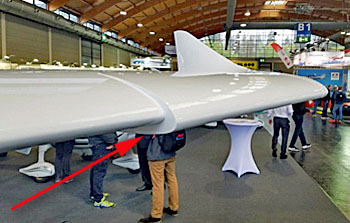
 On its first successful first flight, Flight Design said, “Energy consumption for take-off and cruise was within the expected range, and the temperatures in the system were more positive than expected.”
On its first successful first flight, Flight Design said, “Energy consumption for take-off and cruise was within the expected range, and the temperatures in the system were more positive than expected.”

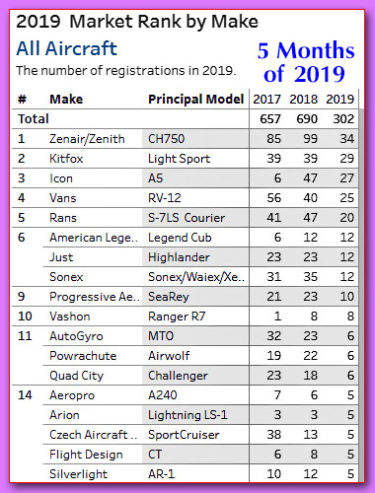 Our first quarterly report in many years should have come about April 1st. It did not. That date came as
Our first quarterly report in many years should have come about April 1st. It did not. That date came as  Digging deeper, the chart shows that longtime market leader
Digging deeper, the chart shows that longtime market leader  Strong SP kit suppliers include
Strong SP kit suppliers include  Yet the real surprise comes when you look at our final chart of this article. Kits appear ascendant since 2013, especially when compared to Special LSA that seems to have found a stable registration rate of around 200 aircraft per year. However, when you combine SLSA with Experimental LSA, you can see that all LSA types number closer to 300 units per year, compared to all SP kits at just shy of 400. Specialty registrations like Experimental Exhibition are steady but at a far smaller unit count.
Yet the real surprise comes when you look at our final chart of this article. Kits appear ascendant since 2013, especially when compared to Special LSA that seems to have found a stable registration rate of around 200 aircraft per year. However, when you combine SLSA with Experimental LSA, you can see that all LSA types number closer to 300 units per year, compared to all SP kits at just shy of 400. Specialty registrations like Experimental Exhibition are steady but at a far smaller unit count.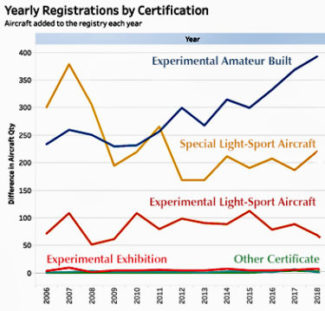 Any ELSA must be shipped from the factory as a bolt-for-bolt copy of the SLSA model, as required under the regulation. No producer can sell an ELSA without first getting approved for a SLSA, so to my mind, combining SLSA and ELSA makes for a fairer comparison to Sport Pilot kit aircraft.
Any ELSA must be shipped from the factory as a bolt-for-bolt copy of the SLSA model, as required under the regulation. No producer can sell an ELSA without first getting approved for a SLSA, so to my mind, combining SLSA and ELSA makes for a fairer comparison to Sport Pilot kit aircraft.
 If that’s an accurate assessment, then let the drooling begin over this beautifully contoured flying machine that can race 135 to 185 miles an hour for a fairly modest investment. I’m writing about Lightning from
If that’s an accurate assessment, then let the drooling begin over this beautifully contoured flying machine that can race 135 to 185 miles an hour for a fairly modest investment. I’m writing about Lightning from  “Lightning LS-1 is designed and built around Jabiru’s powerful 3300 aircraft engine,” noted Arion. “With a displacement of over 200 cubic inches and a direct drive crank, this little beauty has over 120 horsepower on tap for performance rarely matched in a Light-Sport Aircraft.” Lightning has no trouble hitting the LSA speed limit of 120 knots (138 mph).
“Lightning LS-1 is designed and built around Jabiru’s powerful 3300 aircraft engine,” noted Arion. “With a displacement of over 200 cubic inches and a direct drive crank, this little beauty has over 120 horsepower on tap for performance rarely matched in a Light-Sport Aircraft.” Lightning has no trouble hitting the LSA speed limit of 120 knots (138 mph). Most companies list useful load, but Arion said the more meaningful payload can be up to 470 pounds. That will allow two big Americans plus some luggage assuming weight and balance confirms. “Now standard equipped with 40 gallons of fuel, you can go over 800 nautical miles with VFR reserves,” Nick added.
Most companies list useful load, but Arion said the more meaningful payload can be up to 470 pounds. That will allow two big Americans plus some luggage assuming weight and balance confirms. “Now standard equipped with 40 gallons of fuel, you can go over 800 nautical miles with VFR reserves,” Nick added. Taller landing gear permits bigger props on this new kit to allow the speedier model to hit speeds of 160 knots (184 mph). Firewall aft XS is much the same as the classic Lightning including its 42-inch wide cabin.
Taller landing gear permits bigger props on this new kit to allow the speedier model to hit speeds of 160 knots (184 mph). Firewall aft XS is much the same as the classic Lightning including its 42-inch wide cabin.





 The show started the same year LSA arrived on the scene — barely a month after FAA announced the new airplane and pilot certificate category — as the event was initially held in October before shifting to January to avoid hurricane season disruptions that affected the first year.
The show started the same year LSA arrived on the scene — barely a month after FAA announced the new airplane and pilot certificate category — as the event was initially held in October before shifting to January to avoid hurricane season disruptions that affected the first year. The LSA community embraced Sebring enthusiastically as the new segment roared into the aviation space. Dozens of new aircraft producers and the many customers who loved them enjoyed having an event where LSA and Sport Pilot kit aircraft plus ultralights were the leading attraction.
The LSA community embraced Sebring enthusiastically as the new segment roared into the aviation space. Dozens of new aircraft producers and the many customers who loved them enjoyed having an event where LSA and Sport Pilot kit aircraft plus ultralights were the leading attraction. What will Sebring Regional Airport do to promote itself and aviation in the future? “[We] will continue to focus resources and energy toward the development of new programs in emerging aviation areas including manned,
What will Sebring Regional Airport do to promote itself and aviation in the future? “[We] will continue to focus resources and energy toward the development of new programs in emerging aviation areas including manned,  LSA and Sport Pilot kit-oriented enterprises based at Sebring include Lockwood Supply and
LSA and Sport Pilot kit-oriented enterprises based at Sebring include Lockwood Supply and  “The news came as a shock,” Plane & Pilot continued, “with the company suddenly announcing on Wednesday, May 29 that 2019 will be its last year. Three races remain for this year’s series, with events in Russia, Hungary and Japan. In all, the series has included more than 90 races.”
“The news came as a shock,” Plane & Pilot continued, “with the company suddenly announcing on Wednesday, May 29 that 2019 will be its last year. Three races remain for this year’s series, with events in Russia, Hungary and Japan. In all, the series has included more than 90 races.”

 They elaborated that they chose both materials —making this a true composite — for the optimization of aerodynamic qualities, flight characteristic, and reliability. “This addition enabled [us] to make construction decisions based on optimum design and structural integrity rather than purely the cost of production.”
They elaborated that they chose both materials —making this a true composite — for the optimization of aerodynamic qualities, flight characteristic, and reliability. “This addition enabled [us] to make construction decisions based on optimum design and structural integrity rather than purely the cost of production.” Tecnam has long boasted “uncompromising build quality” and P92 MkII has been built to meet requirements for Europe’s CS/VLA standards for aircraft certified to this category. Tecnam offers models meeting the European ultralight category (different than the U.S. interpretation of that term), LSA ASTM standards, and Part 23 fully certified aircraft. They make models using twin Rotax power and an 11-seat regional aircraft (seen briefly in the video alongside the P92 MkII).
Tecnam has long boasted “uncompromising build quality” and P92 MkII has been built to meet requirements for Europe’s CS/VLA standards for aircraft certified to this category. Tecnam offers models meeting the European ultralight category (different than the U.S. interpretation of that term), LSA ASTM standards, and Part 23 fully certified aircraft. They make models using twin Rotax power and an 11-seat regional aircraft (seen briefly in the video alongside the P92 MkII). Inside P92 MkII, “the cabin offers newly designed seats and seat rails which are easily operated and adjustable fore and aft via a single handle with a reinforced area between the rails to make cabin access even easier.” The company continued, “A roomy baggage compartment with internal access accommodates voluminous items. A comfortable armrest and USB charger round out the luxurious interior.”
Inside P92 MkII, “the cabin offers newly designed seats and seat rails which are easily operated and adjustable fore and aft via a single handle with a reinforced area between the rails to make cabin access even easier.” The company continued, “A roomy baggage compartment with internal access accommodates voluminous items. A comfortable armrest and USB charger round out the luxurious interior.” Indeed, outside of the LSA world, many pilots I’ve spoken to believe these aircraft are too lightly built to hold up in flight training, one of the most demanding of all flight activities. “Yes, an experienced pilot may love a LSA,” they may concede, “but these aircraft cannot hold up to regular flight instruction duty.” Enthusiasts may be biased but what would an actual flight school operator say?
Indeed, outside of the LSA world, many pilots I’ve spoken to believe these aircraft are too lightly built to hold up in flight training, one of the most demanding of all flight activities. “Yes, an experienced pilot may love a LSA,” they may concede, “but these aircraft cannot hold up to regular flight instruction duty.” Enthusiasts may be biased but what would an actual flight school operator say?

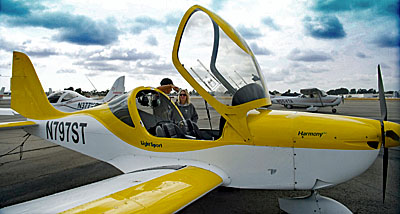
 Sunrise mechanic Matt Wilderman is an A&P with Inspection Authorization. He relates experience since 2009.
Sunrise mechanic Matt Wilderman is an A&P with Inspection Authorization. He relates experience since 2009.